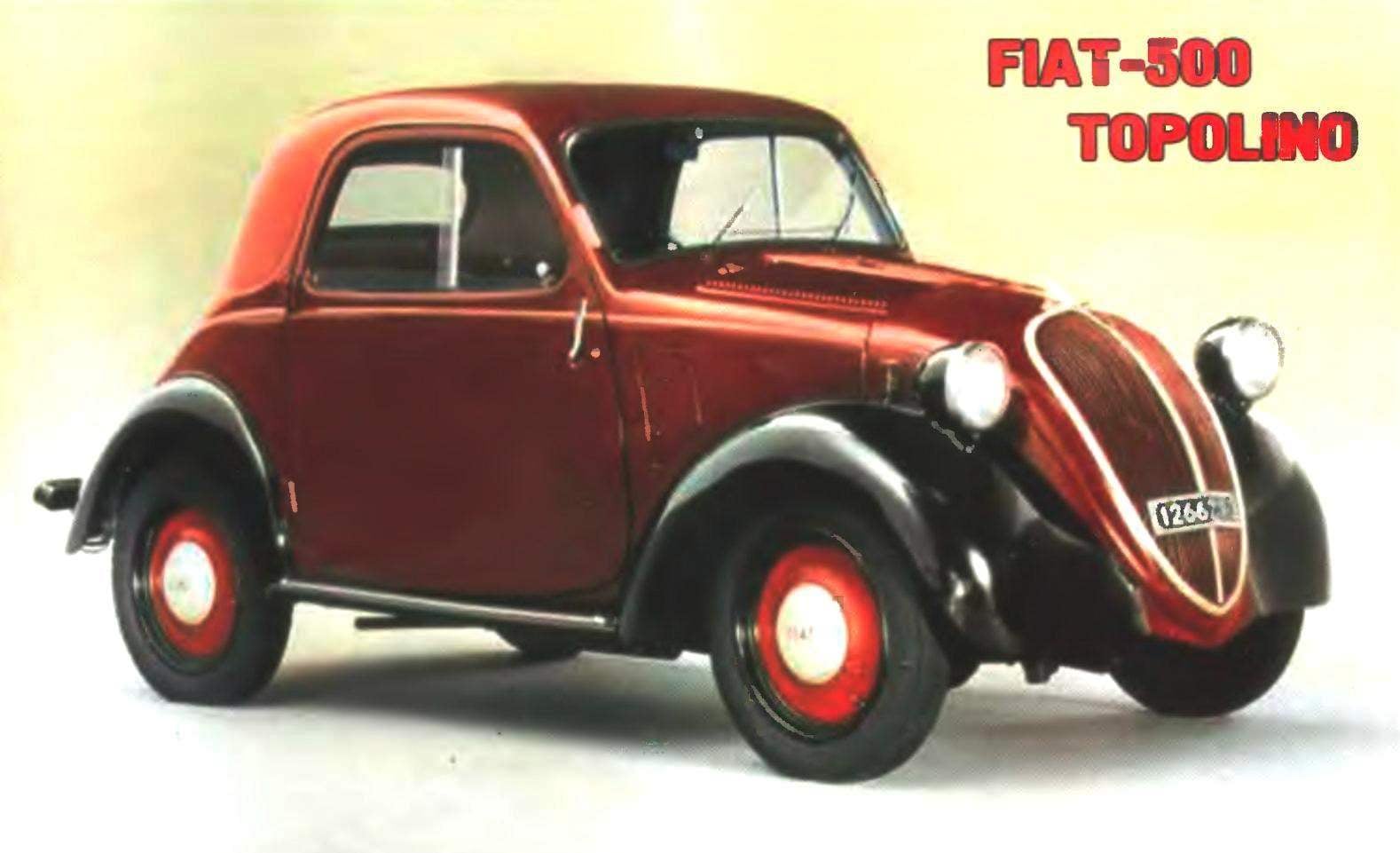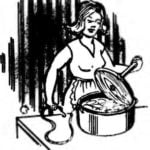
 Compact car FIAT 500 Topolino. With the advent of the automobile mankind has had another dream as soon as possible to buy this vehicle. However, for a large part of the population for many years this dream was very far from realization — too big was the difference between the cost of cars and income of potential buyers.
Compact car FIAT 500 Topolino. With the advent of the automobile mankind has had another dream as soon as possible to buy this vehicle. However, for a large part of the population for many years this dream was very far from realization — too big was the difference between the cost of cars and income of potential buyers.
But the desire of manufacturers to improve the profitability of their companies forced them to realize that a million compact and cheap cars can bring much more profit than a thousand expensive Executive cars.
One of the first to think of that Henry Ford — he put on the conveyor belt is truly a mass-market car Ford-T, the Americans received the nickname “Tin Lizzie.” The popularity of this vehicle speaks volume of production of these cars — he made 15 million copies!
Further to the production of the mass of the vehicle turned other manufacturers: the Italian FIAT company, designed in 1934 compact car FIAT 500 Topolino; French firm Citroen, released in 1949, the people’s car Citroen-2CV; the design office of Ferdinand Porsche, created in 1937, Volkswagen famous car nicknamed the “beetle”, and even the West German company BMW, which began in 1955 for mass production under license of little micro-car BMW-Sally.
The greatest success in this field was reached by the FIAT company for many years, she has created a car class which should be called “smaller!”, releasing with four miniature cars, three of which had a common name — FIAT-500.
The first prototype of the economical double front wheel drive car, equipped with the original three-cylinder radial engine of air cooling, constructed in 1934, on the instructions of the head of FIAT, Senator Giovanni Agnelli, the chief engineer of the company Oreste Sorry. It was truly a people’s car costing up to five thousand lire.
Who knows in which direction to further develop the concept of the “people’s car” at the company FIAT, if the first test race this car, at the wheel which was Angeli, ended well. But fate decreed otherwise — accidental vehicle fire due to short circuit put a cross on the front drive and the motor with air cooling.
Work to create a “people’s car”, however, continued his development requested by 28-year-old designer of Dante Giacosa. To implement the plan of Giovanni Agnelli, the designer began June 1, 1934.
I wonder what the story is virtually identical to the process of creating in Germany the “people’s car” Volkswagen, which is almost at the same time came from a brilliant designer Ferdinand Porsche. Nothing surprising in this — the creation of a “people’s car” in Germany and in Italy was the ideological action of the leaders of the fascist States of Hitler and Mussolini. However, small Volkswagen was released before the war only experienced party in 30 copies, and FIAT in the same period managed to deploy a full-fledged mass production of “five hundredth”.

Designer FIAT 500 Topolino Dante Giacosa
The idea for this car by that time, already fully developed in the head Giacosa, so that the design and manufacturing of the car took only about four months. And this despite the fact that in the construction “parisotoma” was not used of parts or components which are unified with the firm produced cars, re — design had everything including the engine.
For 7 Oct the prototype “five” rolled out of the pilot plant. So expeditiously was conducted and preparation of serial production of cars — the first “five” began to roll off the production line just two years after the beginning of their development, on 15 June 1936.
According to producers, the cost of the car in the first approximation proportional to its mass. To create a cheap machine, it should be made possible, easier. That is why the “people’s car” was designed as a double compartment with a Luggage of 50 kg of cargo.
In machine design Dante Giacosa chose the classic scheme with rear driving wheels and a rear engine. The latter, incidentally, was put forward over axle of the front wheels, which explains the use of independent front suspension — the solution for minicars, frankly, extraordinary. Lower control arms were attached under the clutch housing, and the function of the upper levers performed transverse spring located above clutch housing.

FIAT-500 Topolino of the first series of issue 1936

The geometric scheme of the FIAT-500 Topolino of the first series

The front of the cabin FIAT-500C Topolino:
1 — door handle 2 — windscreen wiper; 3 — control knob kit; 4 — level indicator fuel tank and the temperature of the liquid in the cooling system; 5 — the switch of light of headlights; 6 — rear view mirror; 7 — the switch of illumination of the instrument panel; 8 — the ignition switch; 9 — the switch of indexes of turn; 10 — the switch of a heater of salon; 11 — button choke control of the carburetor; 12 — cigarette lighter plug; 13 — a speedometer; a 14 — foot pedal throttle control of the carburettor (“gas”); 15 — the brake pedal; 16 — the lever transmission; 17 — Parking brake lever; 18 — pedal of the clutch mechanism; 19 — steering wheel; 20 — horn button; 21 — button bonnet

Van based on FIAT-500 Topolino of the first series
The engine of the “five hundredth” — a four-stroke, four-cylinder, in-line, with a displacement of 0,569 L. When you create a motor Giacosa tried to make it as short as possible — for this he designed a crankshaft dukhobory (compare, on the classic Zhigulevskaya engine, the crankshaft rests as much on the five pillars!), to the limit while reducing the distance between adjacent cylinders. Even the cylinders of Giacosa did the minimum possible diameter of 52 mm, and to ensure a predetermined working volume, respectively, increased the stroke of the pistons. In addition, the designer refused mitrinkova duct designed for the circulation of coolant is enabled to move even closer cylinders. As a result, the length of the motor was only 380 mm.
The body of the car rested on a frame made almost in aviation technology in its longitudinal members to reduce their mass, the holes were cut. Neither the body nor the frame alone does not have sufficient rigidity — it was purchased only after their connection.
The doors “five hundredth” opened toward the air flow — at that time, designers were choosing on their own what the front of the door opening to mount the hinges — on the front or the rear. However, by modern standards, this scheme is unacceptable by the incomplete closing of the air flow may on the go to swing the door with all the ensuing consequences.
The side Windows of the FIAT-500 made sliding, allowing to do without Windows and, therefore, cumbersome mechanisms that occupies the internal cavities of the doors. That is why they had been assembled from frame and external panels, the last paste over the inside leatherette, so that the width of the car inside and outside was almost the same.
The trunk was located immediately behind the back seats and load it only from the inside. The spare wheel was mounted outside, in a shallow recess in the rear of the body. This design was quite widespread in the prewar period — in particular, such roof racks and mount the spare wheel provided for the Opel Kadett (and, accordingly, the “Moskvich-400”).
The engine Bay is pretty free due to the unusual layout of the radiator of the cooling system — it is located behind the engine. Thus the contours of the hood are more streamlined than in the classical scheme with the radiator front of the engine.
When designing the machine Giacosa had to find the most simple, workable and affordable design solutions. So, he had to abandon a water pump in the cooling system and use the principle of thermosyphon fluid circulation. Absent the car and the fuel pump — fuel flowed to the carburetor exactly as in Ford’s “Tin Lizzie” — by gravity, due to the fact that the fuel tank capacity 22 litres was installed at the top of the engine compartment, directly under the hood.

The layout of the FIAT 500 Topolino of the first series

FIAT 500A Topolino issue of 1938 — the car of the first series differed in the left position, the appearance of the second wiper and having a front and rear bumpers

FIAT-500C release 1949 — universal style “station wagon”
Production of micro-car, only that received from the Italians affectionate nickname Topolino (little mouse), was launched in 1936. The volume of production of cars in a short time reached 100 cars per day!
The new machine is assembled completely “adult” speed of 85 km/h, came to mind Italians, it has allowed many of them to change to a completely real car with a traditional pre-war Italian bikes and motorcycles.
Appreciated the “five hundredth” and abroad in the same 1936 French firm SIMCA was organized by the licensed production of FIAT 500, called SIMCA-5, and from 1937 to 1940 he was released by the German firm of NSU under the name NSU-FIAT-500. At the same time the Germans along with the Italian version was released the car and the convertible spider, which had put the firm NSU Weinsberg and he and the other had a wooden frame and steel paneling.
Interestingly, minicar FIAT 500 first series, produced until 1938, had right-hand drive — the disadvantage of this country with right-hand traffic was corrected in the next revision, called FIAT-500A, the release of which was produced from 1938 to 1948. In it, the wheel was rotated to the left side, instead of chetvertellipticheskih springs the rear suspension uses semi-elliptic leaf, front and back appeared full bumpers. Before the Second world war the company produced 122 thousand cars FIAT-500 Topolino.
During the war the company FIAT were severely damaged, so that the production of passenger cars had significantly reduced, however, the “five” continued to produce, albeit in limited quantities.
After the war, the issue of the “five hundredth” continued and, as the historians of the car industry, it is Topolino “pulled” by FIAT of the post-war crisis — the proceeds from the sale of the mass of the car were almost the only source of recovery of the company.
At the same time, however, to call post-war “five hundredth” people’s car historians autostructure not solved, because in 1945 it was sold for 720 thousand. — this amount is consistent with the earnings of the average worker for three years. However the car is still bought…
In 1948 Topolino thoroughly modernized. First and foremost was the updated engine — it was equipped with aluminum heads with verhneraspolozhennyh valves — they were operated with rods from the Cam shaft in the crankcase of the motor.
In the fuel system of the car was the fuel pump, instead of the old horizontal carburetor and installed a new vertical, and developed improved intake manifold. As a result, the engine power was increased to 16.5 BHP, which allowed the little micro-car to accelerate to 95 km/h. in Addition, the mechanical brake drum with a diameter of 145 mm was replaced by hydraulic, 220 mm drums.
Technical characteristics of the car series FIAT-500 Topolino

Note: data in brackets refer to modifications of the FIAT 500 station wagon
Updated and interior “five hundredth” — for it has developed a new instrument panel and steering wheel dvuhsvetny. And finally, the machine was equipped with a second windshield wiper. As a result of modernization, the mass of the car, called FIAT-500B increased to 600 kg.
Another modernization of the “five hundredth” produced in 1949. The car was fitted with the new wings, hood, grille, and tires larger and telescopic shock absorbers. In addition, it introduced the heater, the ventilation system and heater front window. With the rear of the car removed the spare tire — it was laid horizontally under the boot floor. In the end, the mass of FIAT-500C increased to 650 kg.
In the late 1940-ies appeal Topolino declined buyers already was not satisfied with a double machine. In response, the firm in 1948, has released a three-door four-seater car-universal FIAT-500 Belvedere. The body of the car, designed in the then fashionable style of “station-wagon”, was wooden planks.
In the mid-1950s, the archaic “five hundredth” already started to affect his sales — buyers needed a more modern “people’s car”. The release of the “five hundredth” was completed in 1955. All the years of production rolled off the line 520 thousand of these machines. Well a FIAT began developing a new “five-hundredth” — the task was again entrusted to Dante Giacosa. But it is quite a different story that we will tell to readers in another time…



